Days 21-25, August 6-10, 2008 (No Malaria)
Right now, I’m in my hostel back in Kuala Lumpur. Today’s accommodations look like the Lincoln Bedroom compared to the last hostel in KL. Tomorrow, I am off to Phuket, Thailand. I am taking today off trying to pay some bills, update the blog, and return some emails.
I landed from Siem Reap, Cambodia a few hours ago and was there for the last 4 days. Cambodia is another one of those, “Where do I begin,” kind of places. I can say this: I didn’t budget enough time to spend there and it was, by far, the most fascinating place I have visited. It is such a strange combination of welcoming, friendly, interesting, and sad all at the same time. The Cambodian people have been through a lot the last 30 years. It is a profoundly poor place where the average shop worker makes around $75/month for wages. Do the math. That is less than $1000/year. Buying something for a dollar at someone’s shop can make is a big deal to them. Tourism is the only significant thing that brings any foreign money into the country and I can’t imagine the poverty level if they didn’t have the Angkor temples close to bring in the tourists (I guess it would be like Laos…even poorer from what I hear). One of the unfortunate results of the poverty is there is a lot of child labor. At any and all tourist attractions, young boys and girls are selling souvenirs so they can to make money for their families. It is very sad. I was very conflicted every day between buying things from the kids, feeling like I was supporting their forced labor, and knowing that they needed the money to eat. It’s really a no win situation. The kids, who all know English, are so charming that it is hard to say no. They are persistent and know exactly what to say to get a few dollars from you.
Cambodia also has a terrible landmine problem. From the American-Vietnam War and through the Cambodian civil war that followed, millions of landmines were buried all over the country. Most were dropped by planes and ended up where they fell including school yards, homes, street, farms etc. The landmines have turned the country into a death trap. Millions of landmines have been disarmed but by most estimates, there are still somewhere around 6 million left in Cambodian soil. The population of Cambodia is just shy of 13 million people. There is one active landmine for every 2 people in Cambodia. Over the last 20 years, over 40,000 Cambodians have been killed or maimed by leftover hidden landmines. Everywhere I went, and especially in the countryside, I was warned to stay only on marked paths due to the threat. In Siem Reap, everywhere you look, you can see people missing limbs. It is grizzly. I have been told that Phnom Penh, the capitol, is significantly worse.
Added to the poverty and the landmines are the still very open wounds of the Khmer Rouge. The Khmer Rouge, led by the dictator Pol Pot, took control of Cambodia in 1975. They wanted to isolate Cambodia internationally and turn it into a communist farming society. Pol Pot forced the relocation of hundreds of thousands of people from the cities to forced labor farms in the countryside. His regime also decided that they needed a social purging and deemed anyone who was educated as a threat to the new Cambodian utopia. Anyone that could speak a foreign language, wore glasses, university professors, and hundreds of thousands of other “threats” were brutally tortured and killed. This effectively removed several generations of thought leaders, social activists, entrepreneurs, and skilled laborers from Cambodian society. They are just starting to recover. No one knows for sure how many people died but most estimates are around 1.5 of the 7.5 millions people living in the country at the time. That is one out of every 5 citizens. Hundreds of thousands more died of starvation as a direct result of Khmer Rouge policies. Anybody under 30 or so doesn’t really remember but almost everyone has been affected through missing or dead family members or friends. Though most everyone to which I spoke about the Khmer Rouge claimed that the country is no longer affected day to day, I could tell that the scar is still there. Comments about them are often thrown into casual conversation. For example, we were driving past a cemetery one day and my guide, Tola, said to me, “Pol Pot regime kill many people there.”
Despite all of this, the Cambodian people are some of the most welcoming and friendly I have ever met. Often when traveling, if you are driving down the road and you smile or wave at someone, they often ignore you are turn away. One thing that stuck me about Cambodians is that everybody returned each wave with a genuine smile. They are very interested in America and American culture and, since so many people know some English, you are often bombarded by questions about home.
The official currency of Cambodia is the Riel but for all intensive purposes, the US dollar is the currency used in day to day life. It is about 4000 Riel to one dollar so they use 1000 Riel notes like quarters. US dollars even come out of all of the ATM machines. Since their economy is based on the dollar though, they, like us, are not too happy about the dollar being down.
Driving in Cambodia is an adventure in and of itself. On the road, you have cars, bicycles, mopeds, and Tuk-tuks. Tuk-tuks are like rickshaws drawn by mopeds. These are the luxury taxis of Cambodia. If you cannot find a tuk-tuk, you have to ride on the back of a moped to get anywhere. The combination of vehicles on the crowded roads is nothing less than chaotic. Officially, there are traffic lights, road signs, and traffic drives on the right side of the road. Practically, these are only suggestions. I asked my guide what the rules of the road were and he replied, “No Rules.” The only rule is that if you hurt someone, you have to pay for their medical care. All of the vehicles weave in and out of each other, run lights, drive through oncoming traffic to jockey for position, and generally scare the hell out of me.
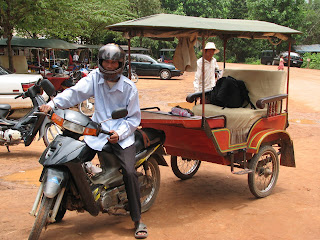
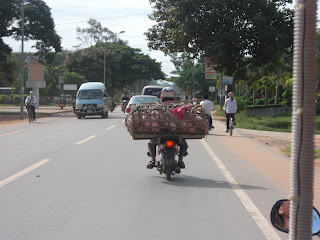
Siem Reap is home to the ruins of the capital of the original Khmer empire dating from the 9th-13th centuries AD. The Khmer Empire ruled most of this area including modern Cambodia, Thailand, and Vietnam. Their kings built monumental temples and government buildings that survive very well preserved to today. This is the main tourist draw to Cambodia. These ruins are truly wonders of the world. In Rome, unless a building was converted to a church, you have to use a lot of imagination to picture what any original structure looked like. At Angkor (the Khmer capital), most of the ruins have been preserved by the jungle so when it was cleared, many look ready for use. This coupled with the size and sheer number of ruins make this a one-of-a-kind spot on Earth. The temples were either dedicated to Hindu Gods or Buddha and were often converted at anytime to meet the needs of the ruling King. The largest temple, Angkor Wat, was built in the early 1100’s, covers an area of 1 square kilometer, and is surrounded by a moat that would make any medieval castle jealous. To me, I didn’t scratch the surface of these impressive ruins. There are still many temples hidden in the jungle that are being uncovered on a regular basis.
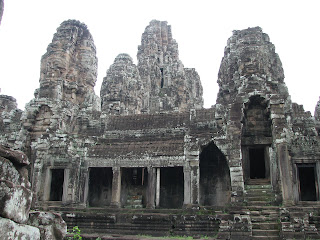
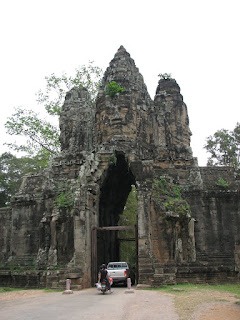
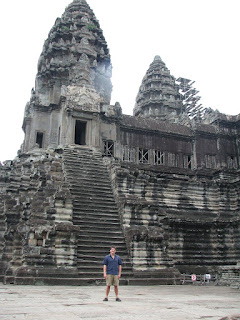
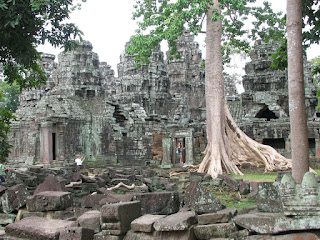
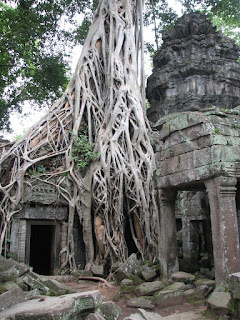
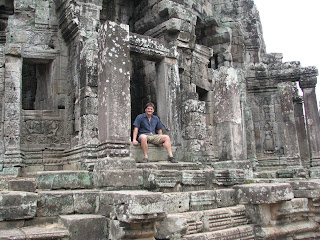
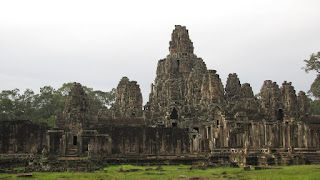
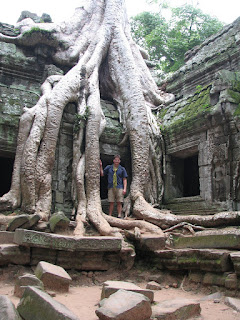
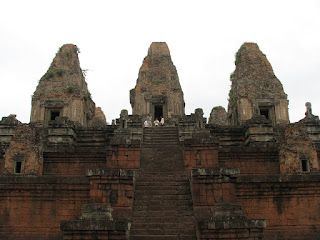
I spent 3 days exploring the ruins with my guide, Tola, and my driver, Mr. Syed.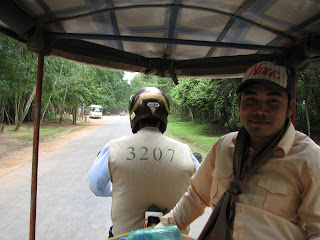
 Tola has been a tour guide for several years, is very knowledgeable about the entire area, and we became good friends. One day, we drove the tuk-tuk about 60 kilometers outside of Siem Reap to visit one of the more remote temples. The temple was a 1 kilometer hike up the side of a mountain after the drive is over. The climb was hot and exhausting but the temple was amazing. The roads, though, once one gets a short distance from Siem Reap, can hardly be called roads. They are more of dirt or mud trails. At one point, the tuk-tuk couldn’t make it through the mud with two passengers so Tola and I had to get out and walk while Mr. Syed drove and pushed the tuk-tuk through. I asked Tola why the road was so bad and he said that a Thai company was hired to fix the road but Thai-Cambodian relations are so bad that the company just left. Apparently, Thai-Cambodian relations are historically bad and now there is a border dispute that most Cambodians are confident will end up in war. Even Tola, being the mild mannered Buddhist he is, said he would be willing to fight the Thais if his country needed him to.
Tola has been a tour guide for several years, is very knowledgeable about the entire area, and we became good friends. One day, we drove the tuk-tuk about 60 kilometers outside of Siem Reap to visit one of the more remote temples. The temple was a 1 kilometer hike up the side of a mountain after the drive is over. The climb was hot and exhausting but the temple was amazing. The roads, though, once one gets a short distance from Siem Reap, can hardly be called roads. They are more of dirt or mud trails. At one point, the tuk-tuk couldn’t make it through the mud with two passengers so Tola and I had to get out and walk while Mr. Syed drove and pushed the tuk-tuk through. I asked Tola why the road was so bad and he said that a Thai company was hired to fix the road but Thai-Cambodian relations are so bad that the company just left. Apparently, Thai-Cambodian relations are historically bad and now there is a border dispute that most Cambodians are confident will end up in war. Even Tola, being the mild mannered Buddhist he is, said he would be willing to fight the Thais if his country needed him to. 
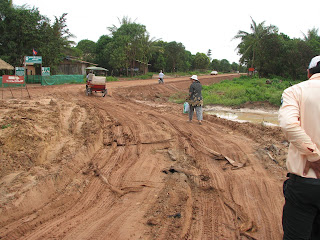
Besides the temples, I also got to experience a lot of the Siem Reap area and Cambodian culture. I made pretty good friends with my tour guide, Tola, and he even took me out with some of his friends one night. They took me to a restaurant a little off of the beaten path for dinner. This particular restaurant serves one dish, beef soup, and is never, ever visited by tourists. I wish you could’ve seen the stares I received when I walked in the place. I would’ve been stared at less if I’d had a cat growing out of my head. As friendly as these people are, they were shocked to see me enter the beef soup restaurant. I soon found out why. Tola told me that I was the first tourist he ever brought there because I had been so respectful and open to Cambodian culture. He thought I could handle a very traditional meal. The meal would’ve better been called “cow soup” than “beef soup.” They set all of the ingredients in front of you with boiling broth in the middle and let you cook the soup to your liking. It’s kind of like a weird cow fondue. The first thing that was set in front of us was a plate with an unidentifiable animal product and a raw egg in the middle. I asked Tola, “what is that?” As if I should’ve already known he says, “It’s the cow brain. We add that last, though, because it will melt if we put it in too early.” Great, the last thing I want is melted cow brain in my soup. The next plate was another unidentifiable animal product: cow nail. I am a pretty adventurous eater but this was a little too much for me. I fought back my nausea as not to offend Tola and his friends. I ate the cow brain and cow nail. After the brain was gone, Tola asked me which I preferred…cow brain or nail? Since the brain was gone already, I thought that I could get out of eating anymore nail and I told him that I enjoyed the brain more. My mistake was not realizing there was more of my preferred cow brain to be ordered. When it came, Tola and his friends told me that they got to eat it often so they would save it for my soup. They were genuine, too. They were happy to think I enjoyed the cow brain and wanted me to enjoy more. I have to stop being so accommodating….
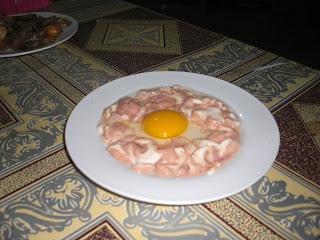
Another interesting thing that I did was to visit a Cambodian floating village. In order to get there, you have to drive about 30 minutes from Siem Reap and the docks are then several kilometers down a dirt path that is more field than road. The Tonle Sap lake near Siem Reap expands to 4 times its dry season size during the rainy season. The dramatic expansion and contraction of the lake has led to the evolution of an entire group of people that follow this cycle. They live their entire lives on boats. Their homes, schools, places of worship, and businesses are all on boats. If they have any animals, they’re on boats, too. They are a nomadic people but instead of following livestock feeding grounds, they follow the water and the fish. If you don’t like your neighbor, you just row down the river a little. If Cambodia is impoverished, these people are the poorest of the poor. They subsist by selling fish and raising crocodiles but the lake has been over fished and the price of crocodile is down so they have been hurt by it financially. You have never seen a happier group of people, though. The children seemed to be having a blast. I guess it would be like having a big pool that connected all your friend’s houses. I guess that would be fun. At one point, it started to downpour and my guide and I went to take a little cover but none of the floating villagers did. I realized that when you live 95% of your life completely wet, a good downpour is probably like a nice breeze to us. We hired a boat to drive us through the village, make a few stops like the crocodile farm, and even take a little excursion on the Tonle Sap to watch the fisherman work. I say it again, if I was looking to experience cultures vastly different than mine, I can’t imagine a more foreign lifestyle.
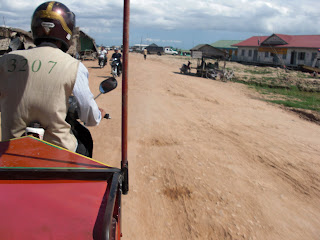
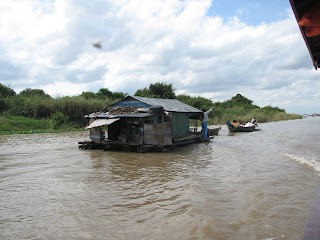
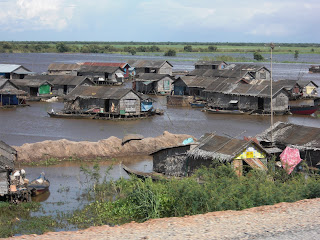
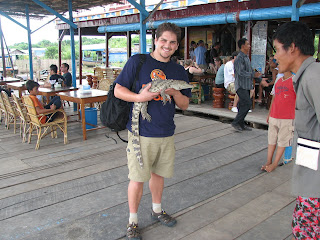
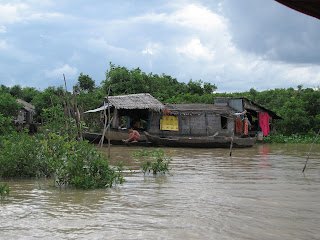
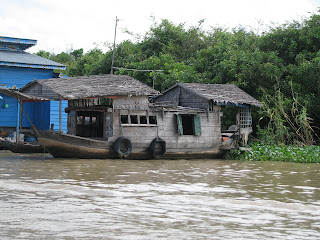
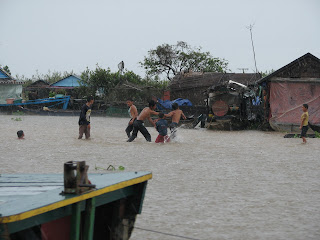
I also got a haircut in Siem Reap. I thought it’d be funny to walk in a barber and ask in Khmer (the language) for a haircut so I asked Tola how to do just that. I figured that I really didn’t care how it turned out so communicating in English wouldn’t be necessary. I walked in and said, “Cheung moi kat sah,” and received the worst haircut of my life. Bad haircut…funny experience.
So that was Cambodia. I am still trying to figure out a way that I can visit Phnom Penh while I am here. I wish I would’ve known that I was going to like it so much and be so fascinated by the culture and people. I would’ve definitely spent some more time there. Hopefully, I will visit one day again. There is so much more there to do!
Despite all of this, the Cambodian people are some of the most welcoming and friendly I have ever met. Often when traveling, if you are driving down the road and you smile or wave at someone, they often ignore you are turn away. One thing that stuck me about Cambodians is that everybody returned each wave with a genuine smile. They are very interested in America and American culture and, since so many people know some English, you are often bombarded by questions about home.
The official currency of Cambodia is the Riel but for all intensive purposes, the US dollar is the currency used in day to day life. It is about 4000 Riel to one dollar so they use 1000 Riel notes like quarters. US dollars even come out of all of the ATM machines. Since their economy is based on the dollar though, they, like us, are not too happy about the dollar being down.
Driving in Cambodia is an adventure in and of itself. On the road, you have cars, bicycles, mopeds, and Tuk-tuks. Tuk-tuks are like rickshaws drawn by mopeds. These are the luxury taxis of Cambodia. If you cannot find a tuk-tuk, you have to ride on the back of a moped to get anywhere. The combination of vehicles on the crowded roads is nothing less than chaotic. Officially, there are traffic lights, road signs, and traffic drives on the right side of the road. Practically, these are only suggestions. I asked my guide what the rules of the road were and he replied, “No Rules.” The only rule is that if you hurt someone, you have to pay for their medical care. All of the vehicles weave in and out of each other, run lights, drive through oncoming traffic to jockey for position, and generally scare the hell out of me.
Siem Reap is home to the ruins of the capital of the original Khmer empire dating from the 9th-13th centuries AD. The Khmer Empire ruled most of this area including modern Cambodia, Thailand, and Vietnam. Their kings built monumental temples and government buildings that survive very well preserved to today. This is the main tourist draw to Cambodia. These ruins are truly wonders of the world. In Rome, unless a building was converted to a church, you have to use a lot of imagination to picture what any original structure looked like. At Angkor (the Khmer capital), most of the ruins have been preserved by the jungle so when it was cleared, many look ready for use. This coupled with the size and sheer number of ruins make this a one-of-a-kind spot on Earth. The temples were either dedicated to Hindu Gods or Buddha and were often converted at anytime to meet the needs of the ruling King. The largest temple, Angkor Wat, was built in the early 1100’s, covers an area of 1 square kilometer, and is surrounded by a moat that would make any medieval castle jealous. To me, I didn’t scratch the surface of these impressive ruins. There are still many temples hidden in the jungle that are being uncovered on a regular basis.
I spent 3 days exploring the ruins with my guide, Tola, and my driver, Mr. Syed.
Besides the temples, I also got to experience a lot of the Siem Reap area and Cambodian culture. I made pretty good friends with my tour guide, Tola, and he even took me out with some of his friends one night. They took me to a restaurant a little off of the beaten path for dinner. This particular restaurant serves one dish, beef soup, and is never, ever visited by tourists. I wish you could’ve seen the stares I received when I walked in the place. I would’ve been stared at less if I’d had a cat growing out of my head. As friendly as these people are, they were shocked to see me enter the beef soup restaurant. I soon found out why. Tola told me that I was the first tourist he ever brought there because I had been so respectful and open to Cambodian culture. He thought I could handle a very traditional meal. The meal would’ve better been called “cow soup” than “beef soup.” They set all of the ingredients in front of you with boiling broth in the middle and let you cook the soup to your liking. It’s kind of like a weird cow fondue. The first thing that was set in front of us was a plate with an unidentifiable animal product and a raw egg in the middle. I asked Tola, “what is that?” As if I should’ve already known he says, “It’s the cow brain. We add that last, though, because it will melt if we put it in too early.” Great, the last thing I want is melted cow brain in my soup. The next plate was another unidentifiable animal product: cow nail. I am a pretty adventurous eater but this was a little too much for me. I fought back my nausea as not to offend Tola and his friends. I ate the cow brain and cow nail. After the brain was gone, Tola asked me which I preferred…cow brain or nail? Since the brain was gone already, I thought that I could get out of eating anymore nail and I told him that I enjoyed the brain more. My mistake was not realizing there was more of my preferred cow brain to be ordered. When it came, Tola and his friends told me that they got to eat it often so they would save it for my soup. They were genuine, too. They were happy to think I enjoyed the cow brain and wanted me to enjoy more. I have to stop being so accommodating….
Another interesting thing that I did was to visit a Cambodian floating village. In order to get there, you have to drive about 30 minutes from Siem Reap and the docks are then several kilometers down a dirt path that is more field than road. The Tonle Sap lake near Siem Reap expands to 4 times its dry season size during the rainy season. The dramatic expansion and contraction of the lake has led to the evolution of an entire group of people that follow this cycle. They live their entire lives on boats. Their homes, schools, places of worship, and businesses are all on boats. If they have any animals, they’re on boats, too. They are a nomadic people but instead of following livestock feeding grounds, they follow the water and the fish. If you don’t like your neighbor, you just row down the river a little. If Cambodia is impoverished, these people are the poorest of the poor. They subsist by selling fish and raising crocodiles but the lake has been over fished and the price of crocodile is down so they have been hurt by it financially. You have never seen a happier group of people, though. The children seemed to be having a blast. I guess it would be like having a big pool that connected all your friend’s houses. I guess that would be fun. At one point, it started to downpour and my guide and I went to take a little cover but none of the floating villagers did. I realized that when you live 95% of your life completely wet, a good downpour is probably like a nice breeze to us. We hired a boat to drive us through the village, make a few stops like the crocodile farm, and even take a little excursion on the Tonle Sap to watch the fisherman work. I say it again, if I was looking to experience cultures vastly different than mine, I can’t imagine a more foreign lifestyle.
I also got a haircut in Siem Reap. I thought it’d be funny to walk in a barber and ask in Khmer (the language) for a haircut so I asked Tola how to do just that. I figured that I really didn’t care how it turned out so communicating in English wouldn’t be necessary. I walked in and said, “Cheung moi kat sah,” and received the worst haircut of my life. Bad haircut…funny experience.
So that was Cambodia. I am still trying to figure out a way that I can visit Phnom Penh while I am here. I wish I would’ve known that I was going to like it so much and be so fascinated by the culture and people. I would’ve definitely spent some more time there. Hopefully, I will visit one day again. There is so much more there to do!
7 comments:
Good story about your Cambodian meal. I was openly laughing at work. Rename the blog - The Mad Cow Disease Blog and keep us updated on whether or not you have it. In all seriousness, keep up the posting. It's a good mix of humor and education.
Still completely amazed at everything Mr. Dave. You are definitely turning this into a book when get back. Didn't enjoy history in school, but like it coming from you. Already looking forward to your next entry. BTW, I also can't stand it when multiple world clocks are not synched to the same exact minute. Have fun bro. Talk to you soon.
Tim
B - did you add extra hot sauce to the cow brains? I can't wait for the entry on Thailand. Are they watching the Olympics where you are?
Shannon K.
Uhm...when on vacation in the past...anything below the level of a Marriott I considered "roughing it".
Amazing to see how other people live and how it makes me thankful to live here. Gotta quick laugh from your blog...do you pronounce the name of the next city that you're visting the way I think you do?
Can you please remove the picture of that stuff that looks like turds with a fried egg on top?
I've had a slab of ribs and about 10 Bud Lights and it makes me want to boot.
Thank you in advance for your cooperation.
Respectfully,
Liam
David,
I have missed several days of your blogs, due to the election, but I just read up on Cambodia. Your very interesting in presenting the country to us back home. The cow brain was a bit much for me...and you got more of it. Very funny.
Your very brave to be there on your own and even more brave to try all the foods of the lands. I could not stomach what you have eaten.
Keep up the good blogging.
Hugs from
Mrs. H.
You're probably almost home at this point. What a great journey.
Zack was just assigned a report on Cambodia so I was rereading those posts. Cambodia seems fascinating. So much that is deeply depressing, deeply uncomfortable yet you met kind people, looking to the future. Very inspiring. Thanks for all the great info.
Welcome back home!
Maria
Post a Comment